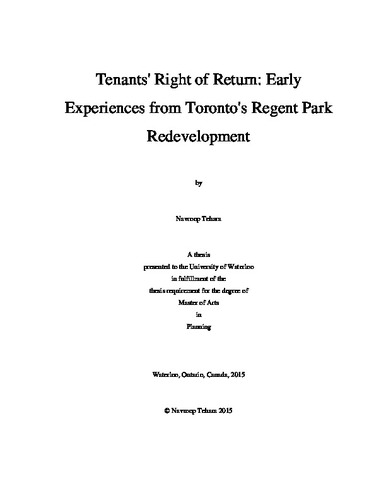| dc.description.abstract | Starting around the 1950s, the creation of public housing projects through the North American Urban Renewal period had a tremendous impact on lower income households and racialized minorities. The development of public housing projects resulted in many residents being forcefully moved out of their communities and relocated involuntarily. The displacement faced by households resulted in the abrupt erosion of tightly knit social networks and loss of community. Some 50 years later, the housing projects developed in the period of Urban Renewal are being demolished as part of a large scale public housing redevelopment initiative in the United States, called HOPE VI. The fear of displacement, and loss of community, has negatively framed attitudes towards redevelopment among social housing tenants. Tenants have been sceptical of the proposed benefits of redevelopment because of issues of displacement and loss of their community due to gentrification. Scepticism and fear of displacement from the community has prompted tenants and housing activists to call for a legal Right of Return. The Right of Return is an important policy that has been designed to ensure that social housing residents impacted by the redevelopment of their community have legal right to return to their home once redevelopment has been completed. Previous research on public housing redevelopment has noted that very few tenants have been able to return to their community despite being given a Right of Return. In Canada, a large scale public housing redevelopment plan of Canada’s oldest and largest public housing community was initiated in 2005. The redevelopment has placed an emphasis on giving tenants a legal Right of Return. The Right of Return policy in the context of the Regent Park Redevelopment in Toronto has yet to be investigated. As a result, the research explores how the policy of Right of Return has operated in the first two phases of redevelopment. Methodology included interviews with 12 key informants who represent a diversity of actors impacted or involved in the redevelopment, and a review of associated planning documents. The Right of Return has been influenced by a variety of actors and interests, such as the market, and the local government. In Regent Park, the Right of Return operates through a robust and well defined policy framework that has allowed the majority of tenants to return to Regent Park. | en |

